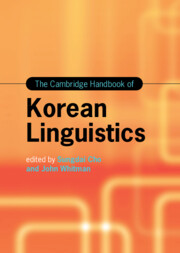Book contents
- The Cambridge Handbook of Korean Linguistics
- Cambridge Handbooks in Language and Linguistics
- The Cambridge Handbook of Korean Linguistics
- Copyright page
- Contents
- Figures
- Tables
- Contributors
- Preface
- Acknowledgments
- Abbreviations
- Part I Korean Overview
- Part II Phonetics and Phonology
- Part III Morphology and Syntax
- Part IV Semantics and Pragmatics
- Chapter 17 Subjectivity and Intersubjectivity in Korean Grammar
- Chapter 18 Discourse Studies in Korean
- Chapter 19 Metaphoric and Metonymic Patterns with the Body-Part Term Nwun “Eye(s)” in Korean
- Chapter 20 Wh-Indefinites
- Chapter 21 “Expletive” Negation in Korean
- Chapter 22 Case Stacking in Korean: Argument Structure or Information Structure?
- Part V Sociolinguistics and Psycholinguistics
- Part VI Language Pedagogy
- Index
- References
Chapter 19 - Metaphoric and Metonymic Patterns with the Body-Part Term Nwun “Eye(s)” in Korean
from Part IV - Semantics and Pragmatics
Published online by Cambridge University Press: 30 September 2022
- The Cambridge Handbook of Korean Linguistics
- Cambridge Handbooks in Language and Linguistics
- The Cambridge Handbook of Korean Linguistics
- Copyright page
- Contents
- Figures
- Tables
- Contributors
- Preface
- Acknowledgments
- Abbreviations
- Part I Korean Overview
- Part II Phonetics and Phonology
- Part III Morphology and Syntax
- Part IV Semantics and Pragmatics
- Chapter 17 Subjectivity and Intersubjectivity in Korean Grammar
- Chapter 18 Discourse Studies in Korean
- Chapter 19 Metaphoric and Metonymic Patterns with the Body-Part Term Nwun “Eye(s)” in Korean
- Chapter 20 Wh-Indefinites
- Chapter 21 “Expletive” Negation in Korean
- Chapter 22 Case Stacking in Korean: Argument Structure or Information Structure?
- Part V Sociolinguistics and Psycholinguistics
- Part VI Language Pedagogy
- Index
- References
Summary
Chapter 19 investigates the conceptual mappings of conventional figurative expressions, specifically idioms and collocations containing the body-part term nwun “eye(s)” in Korean. Working within the framework of conceptual metaphor theory (Lakoff and Johnson 1980), the study explores the types of conceptual shift that give rise to extended meanings and discusses how extension mechanisms draw on shared features between source and target domains. Common Korean expressions involving the eyes involve vision, persons, time, events/processes, perception (e.g., attention, attraction, interest, judgment), mind activities (e.g., thinking, knowing, understanding), and emotions (e.g., anger, avarice, surprise). These figurative expressions are motivated by the basic experiences of eye behavior, eye appearance, and vision, as well as by our interactions with people and environments. The findings of this study contribute to our understanding of the influence of embodiment in language in general and in Korean in particular.
- Type
- Chapter
- Information
- The Cambridge Handbook of Korean Linguistics , pp. 554 - 580Publisher: Cambridge University PressPrint publication year: 2022

